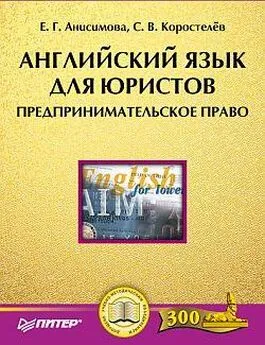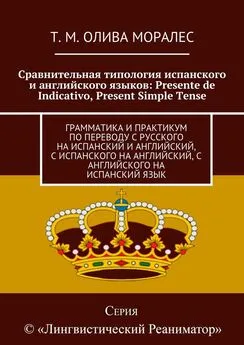Станислав Коростелев - Английский язык для юристов. Предпринимательское право
- Название:Английский язык для юристов. Предпринимательское право
- Автор:
- Жанр:
- Издательство:046ebc0b-b024-102a-94d5-07de47c81719
- Год:2006
- Город:СПб
- ISBN:5-469-01382-0
- Рейтинг:
- Избранное:Добавить в избранное
-
Отзывы:
-
Ваша оценка:
Станислав Коростелев - Английский язык для юристов. Предпринимательское право краткое содержание
Настоящее учебное пособие предназначено для овладения лексикой в области предпринимательского и коммерческого права студентами лингвистических вузов и студентами гражданско-правовой специализации юридических вузов.
Книга призвана дать преподавателям и студентам специальный языковой и профессиональный материал, ориентированный на повышение качества профессиональной подготовки в области правовой лингвистики и международного бизнеса.
Английский язык для юристов. Предпринимательское право - читать онлайн бесплатно ознакомительный отрывок
Интервал:
Закладка:
The relationship between the drawee bank and its customer is that of both debtor and creditor and agent and principal. The relationship arises out of the express or implied contract that occurs when the customer opens a checking account with the bank. The bank becomes a debtor when money is deposited in the bank by the customer. At this time, the customer is owed money by the bank and is, therefore, a creditor. When an overdraft occurs, that is, when the bank pays out more than the customer has on deposit, the debtor-creditor role reverses, and the bank becomes the creditor. The bank acts as the customer's agent when it collects or attempts to collect checks or other negotiable instruments made payable to the customer.
The drawee bank is under a duty to honor all checks drawn by its customers when there are sufficient funds on deposit in the customer's account. If there are insufficient funds on deposit, the bank may charge the customer's account even if it creates an overdraft.
A bank is under no obligation to a customer to pay a stale check unless it is certified. A stale check is a check that is presented for payment more than six months after its date. A bank, however, may honor a stale check without liability to its customer if it acts in good faith.
A forgery is the fraudulent making or alteration of a writing. A forgery is committed when a person fraudulently writes or alters a check or other form of commercial paper to the injury of another. The commission of forgery is a crime, subject to a fine and imprisonment. The offering of a forged instrument to another person when the offerer knows it to be forged is also a crime, known as uttering. If a bank, in good faith, pays the altered amount of a check to a holder, it may deduct from the drawer's account only the amount of the check as it was originally written.
The depositor is also protected against a signature being forged. When a checking account is opened, the depositor must fill out a signature card, which is permanently filed at the bank. Thereafter, the bank is held to know the depositor's signature. The bank is liable to the depositor if it pays any check on which the depositor's signature has been forged.
Payor banks are required to either settle or return checks quickly. If they do not do so, they are responsible for paying them. If the payor bank is not the depositary bank, it must settle for an item by midnight of the banking day of receipt.
If the payor bank is also the depositary bank, it must either pay or return the check or send notice of its dishonor on or before its midnight deadline. In this case, the bank's midnight deadline is midnight of the next banking day following the banking day on which it receives the relevant item.
Depositors, in general, owe a duty to the banks in which they have checking accounts to have sufficient funds on deposit to cover checks that they write. They must also examine their bank statements and canceled checks promptly and with reasonable care and notify the bank quickly of any discrepancies.
Many banks now offer overdraft protection service to their depositors, which cover small overdrafts that are usually caused by the mistake of the drawer in balancing the checkbook. With this service, the bank honors small overdrafts and charges the depositor's account. This service saves the drawer the inconvenience and embarrassment of having a check returned to a holder marked insufficient funds.»
Depositor has a duty to examine their bank statements and canceled checks promptly and with reasonable care when they are received from the bank. They must report promptly to the bank any forged or altered checks. If they do not do so, depositors cannot hold the bank responsible for losses due to the bank's payment of a forged or altered instrument.
Drawers may order a bank to stop payment on any item payable on their account. If a bank fails to stop payment on a check, it is responsible for any loss suffered by the drawer who ordered the payment stopped. The bank, however, may take the place of any holder, holder in due course, payee, or drawer who has rights against others on the underlying obligation. This right to be substituted for another is known as the bank's right of subrogation. It is designed to prevent loss to the bank and unjust enrichment to other parties.
Exercise 1. Comprehension questions:
1. Give definition of a check.
2. Identify special types of checks.
3. Identify the parties relating to a check.
4. What do the cashier's check and traveler's check have in common?
5. What are the requirements for traveler's check?
6. Explain what a certified check is.
7. In what situation postdating is practiced?
8. What are the benefits of electronic fund transfers?
Exercise 2. Find in the text English equivalents to the following:
Тратта, выставленная одним банком на другой; чек – выписанный банком на себя; чек с надписью банка о принятии к платежу; банк-инкассатор; банк-депозитарий; подлог; банк-посредник; превышение кредита; банк-плательщик; банк-представитель; банк, переводящий средства; просроченный чек; замена одного кредитора другим; чек, выписанный банком на другой банк и подписанный кассиром банка, выписавшего чек; переуступка
Exercise 3. Consult recommended dictionaries and give words or phrases to the following definitions:
Чекодержатели; выставление чеков; выдача чеков; отзыв чека; реквизиты чека; оплата чека; депонирование средств; индоссированный чек; утраченный чек; подложный чек; передача прав по чеку; переводной чек; инкассирование чека; аваль чека; операции по счету; кредитование счета; оплата услуг банка; банковская комиссия; списание денежных средств со счета.
Exercise 4. Be ready to talk on one of the following topics:
1. Explain the form necessary for an instrument to be a check.
2. Differentiate between a bank draft and a cashier's check.
3. Compare the liability of parties to a check certified by the drawer with that of a check certified by the payee.
4. Outline a check's life cycle.
5. Explain the duties of a depositor relative to bad checks and examining accounts.
Exercise 5. Make up your own dialog on the case: In Cambridge Trust Co. v. Carney, defendant was a cosignatory with her husband on his business account in order to «insure» payment pursuant to a preliminary support agreement. After receiving an initial payment of $38,000, defendant neither deposited money in, withdrew money from nor received any statement from the bank regarding the joint account. Three month after the initial payment, defendant's husband deposited worthless check for $7,100, drew $6,000 against it, and disappeared into the gloaming. Bank sued defendant on the$5,902.88 overdraft. The New Hampshire Supreme Court held that since defendant neither participated in the transaction creating the overdraft nor received funds as a result of it, she could not be held liable for payment of it.
Unit 15
The Nature of the Insurance Contract
Сущность договора страхования
Страхование осуществляется на основании договоров имущественного или личного страхования, заключаемых гражданином или юридическим лицом (страхователем) со страховой организацией (страховщиком) (глава 48 ГК РФ).
По договору страхования одна сторона (страховщик) обязуется за обусловленную договором плату (страховую премию) при наступлении предусмотренного в договоре события (страхового случая) возместить другой стороне (страхователю) или иному лицу, в пользу которого заключен договор (выгодоприобретателю), причиненные вследствие этого события убытки (выплатить страховое возмещение) в пределах определенной договором суммы (страховой суммы).
– beneficiary – бенефициарий; выгодоприобретатель
– binder – временный страховой документ (до оформления полиса)
– comprehensive coverage – страхование нескольких видов (например, имущества) по одному договору
– concealment – сокрытие, укрывательство; утаивание, умалчивание
– double indemnity – выплата страховой суммы в двойном размере (если смерть застрахованного наступила в результате несчастного случая)
– estoppel – лишение права возражения, лишение стороны права ссылаться на какие-либо факты или оспаривать какие-либо факты
– indemnify – гарантировать возмещение вреда, ущерба
– insurable interest – страховой интерес
– insurance – страхование, страховая премия, страховой полис
– insured – страхователь || застрахованный
– insurer – страховщик
– misrepresentations – введение в заблуждение; искажение фактов
– no-fault insurance – страхование от вреда, наступающего без вины страхователя
– policy – полис (страховой)
– premium – страховая премия, страховой взнос
– underwriter – поручитель-гарант, страховщик
– waiver – отказ (от права, от претензии), изъятие (из общих правил); отступление; исключение; освобождение (от обязательств)
– waiver of premium – освобождение от уплаты страховых взносов
– warranty – гарантия; поручительство, ручательство; оговорка
The principal protection against losses from hazards is insurance. Insurance is a transfer of the risk of economic loss from the buyer to the seller, or the insurance company. The principle underlying insurance is the distribution of risk – which holds that small contributions made by a large number of individuals can provide sufficient money to cover the losses suffered by a few as they occur each year. The function of insurance is to distribute each person's risk among all others who may or may not experience losses.
Читать дальшеИнтервал:
Закладка:










